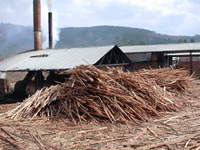IIEC Recent News
Economic Modelling for the Renewable Energy Strategy Formulation in South Africa
 The South African renewable energy white paper was approved by cabinet in November 2003. The essence of the paper is a target of “an additional 10 000GWh of renewable energy contribution to final energy consumption annually by 2013 to be produced mainly from biomass, wind, solar and small-scale hydro. The initial delay in the approval of this target was caused by the absence of an estimate of the macro-economic impacts of pursuit of the target, primarily through direct fiscal subsidy of the technologies in question. This financial and economic analysis study was aimed at assisting the South African Department of Minerals and Energy (DME) with the selection of the optimal mix of technologies for fulfilling the renewable energy additional annual target contribution of 10 000 GWh., using a least-cost basis for South African society. In order to select the least-cost RE technology mix, supply curves have been drawn up for each of landfill gas; pulp, paper and sugar industries; solar water heating, small hydro and wind. IIEC provided technical input on the wind technology component in determination of the total national resource and derivation of a financial cost curve for this technology across various resource categories.
The South African renewable energy white paper was approved by cabinet in November 2003. The essence of the paper is a target of “an additional 10 000GWh of renewable energy contribution to final energy consumption annually by 2013 to be produced mainly from biomass, wind, solar and small-scale hydro. The initial delay in the approval of this target was caused by the absence of an estimate of the macro-economic impacts of pursuit of the target, primarily through direct fiscal subsidy of the technologies in question. This financial and economic analysis study was aimed at assisting the South African Department of Minerals and Energy (DME) with the selection of the optimal mix of technologies for fulfilling the renewable energy additional annual target contribution of 10 000 GWh., using a least-cost basis for South African society. In order to select the least-cost RE technology mix, supply curves have been drawn up for each of landfill gas; pulp, paper and sugar industries; solar water heating, small hydro and wind. IIEC provided technical input on the wind technology component in determination of the total national resource and derivation of a financial cost curve for this technology across various resource categories.
The same input data as that used for drawing up the supply curves was also used for macroeconomic impact analysis, undertaken by Conningarth Economists. This analysis, which uses a partial general equilibrium econometric model that incorporates the South African Social Accounting Matrix (SAM), assesses the impact that the introduction of RE technologies will have on parameters such as employment creation, low income household incomes, and Gross Domestic Product.
The net impact on GDP of investing in RE technologies rather than in a coal-fired power station in achieving the ten-year target has now been modelled to be as high as 1 000 million Rand (Rand 6.3=US$1) per year (2003). This impact includes both the initial construction phase as well as ongoing operations. This impact is to be achieved through support of new generating facilities beyond the financially viable level of approximately 5 400 GWh annually. The study quantified the first order cost-benefit of pursuing the target through direct fiscal subsidisation.

